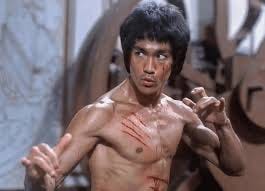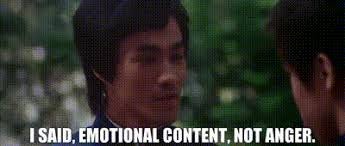It should be no secret that I’m a movie fanatic. I watched six of them this weekend and four were movies I’d already seen at least a dozen times. Conversely, I can probably count the number of TV series I’ve watched all the way through on one hand. Look, I can’t help it, I’m just an old-fashioned movie guy who likes his stories wrapped up in 90-140 minutes. That said, even I have noticed that for some reason which defies easy explanation, TV series these days seem to be packing their episodes with bad martial arts sequences.
I’m old enough to have seen the original “Star Wars” trilogy in theaters, and so when I sat down to watch “The Acolyte”, I expected a show about Jedi Knights fighting bad guys with swords made of energy rather than steel, and who sometimes supplement their “blade” combat by using “The Force” to subtly manipulate the environment around them. So, you can imagine my confusion when this new Star Wars series opened with a young Jedi apprentice approaching a Jedi Master and dropping into a kung fu crouch as if she planed to engage this Jedi Master in some kind of half-assed Karate routine.
And it was awful in all the ways that martial arts sequences between actors who aren’t natural martial artists, or who haven’t been put through months of training prior to shooting always are. Everything in these fights moves at one-quarter speed, blocking moves are performed seemingly before strikes are even begun, and everyone gets as much time as they need to spin in circles, fly through the air or do multiple backflips, even when doing so unnecessarily exposes them to counterattacks. It always seems as if the actors had just enough time to memorize the basic moves, but not enough time to learn do them at speed or to make the combat look realistic in any way. TV fights often lack what Bruce Lee called “emotional content.”
I noticed the same thing with “Rings of Power” a series loosely based on Tolkien’s “The Lord of the Rings” and “The Hobbit”, where the medieval sword, spear and bow combat I had become accustomed to seeing in the feature films gave way to gravity-defying “Wire-Fu” combat that seemed pulled right out of “Crouching Tiger, Hidden Dragon”… though with none of the technical proficiency of Ang Lee’s martial arts masterpiece.
Martial arts are about economy of motion. We fight better and more effectively when we force our opponent to work harder than we do. If on the other hand, like Arondir from “The Rings of Power”, you reveal yourself to your opponent in combat by exploding out of a wooden handcart and doing a quadruple full body somersault through the air without landing a single blow… you may be doing a lot of things, but most of them are stupid, and none of them will help you win the fight.
I understand the need for TV shows to look cool, but flying around like a humming bird during a fist fight is starting to feel less and less cool, the more of it I see. Certainly there is no comparison to a martial arts masterpiece like “Enter the Dragon.” Bruce Lee barely moves when he fights. He seems to defy gravity even when his feet stay planted firmly on the ground.
And it’s the coolest thing you’ll ever see.
“Acolyte” and “Rings of Power” are hardly the only examples of TV shows trying to improve what cannot be improved upon. These days, just about everything on TV seems absolutely filthy with mediocre Kung Fu…
So what on Earth is going on here?
Much of the difference, I think, can be explained by the different ways in which movies and TV shows are produced. When a movie is first greenlit, there begins several months of “pre-production.” The nature of this pre-production process makes possible an aggressive training schedule for the actors to prepare for action sequences written into scripts which won’t change much before production starts.
Stories about the training Keanu Reeves went through to get ready for both “The Matrix” and the “John Wick” franchises are legendary, as was Uma Thurman’s training process for “Kill Bill”, which was done under the tutelage of legendary martial arts choreographer Yuen Woo Ping. Chad Stahelski and David Leitch, both now accomplished directors in their own right, ran the action second unit for “The 300” and reportedly put their actors through an appropriately brutal training regimen to get ready for the shoot. Henry Cavill is rumored to have been in sword training for “Highlander” for much of the last year. And Bruce Lee and Jackie Chan were both so committed to fight sequence realism that they carried an entire team of highly-trained martial arts experts with them wherever they went to act as their on-screen foils. Brad Allan who went on to do stunt and fight coordination on some of the biggest blockbusters of the last thirty years got his start on Jackie Chan’s fight team and, as far as I can tell, is one of the few Westerners ever to face off against Jackie in one of his Chinese movies.
But television is a very different animal. In TV, late season scripts are often still being “broken” and/or written as the first episodes are being shot. A complex fight sequence may be written for a season finale even while those actors are busy shooting earlier episodes and therefore marginally available for intensive training programs. This problem revealed itself not only in series like “Acolyte” and “Rings of Power” but also “Ashoka”, “One Piece” and others, where the martial arts sequences looked more like rote repetition of CGI-assisted choreography than real combat.
Nevertheless a certain kind of arms race has taken over premium cable and streaming TV production in which the producers and showrunners look to provide the same kind of martial action as their counterparts on the feature film side… despite producing increasingly mediocre results.
I think much of the blame has to be placed at the feet of Darth Maul. Actor Ray Park is a highly accomplished martial artist and no one had ever seen anything like Maul in the Star Wars universe before he took on Obi Wan and Qui-Gon Jinn with his double-bladed light saber and acrobatic combat moves. It was undeniably cool, and while I loved the idea that different species or cultures might use Light Sabers to fight in novel ways (in the same way that humans might choose to learn boxing, kung fu, jujitsu or Krav Maga), Darth Maul’s acrobatic style quickly became the rule in the Star Wars universe, rather than the exception. The success of that fight sequence put pressure on Star Wars creators to keep upping the ante in each new climactic fight sequence… not only in the movies, but eventually in the spinoff TV shows as well.
And the thing is, it’s all totally unnecessary.
These are “Jedi Knights”, not “Jedi Dervishes”… calm restrained stoicism is the name of their game. As cool as the Darth Maul fight may have been, the ultimate expression of Jedi combat will always be Luke Skywalker fighting the crew of Jaba’s sail barge over the Sarlac Pit in the Dune Sea. Luke’s primary weapon in the fight is his light saber. When he does move acrobatically, it is not so that the audience can “ooh” and “ahh” at his ability to defy gravity. Rather these are evasion maneuvers designed to get him out of harm’s way as quickly and efficiently as possible. To the extent he uses The Force at all it is to improve his lethality with the saber, or to subtly redirect incoming fire or move inanimate objects, rather than to levitate himself around the environment in a way that reeks of CGI-assisted unreality. And certainly none of his opponents ever gets close enough to deliver a punch or a kung fu strike, as Indara (Carrie Anne Moss) allows the Acolyte to do over-and-over again.
But Luke versus Jabba’s entire army is still a great combat sequence. More importantly, for the purposes of this essay, it is repeatable and scaleable for television.
The problem with much of what’s on TV these days has more to do with unnecessary political messaging and mediocre storytelling. People want great characters in their TV shows, the kind that makes them want to stick around for three to five years. As a matter of fact, creating characters audiences care about is an absolute prerequisite for convincing them to care what happens to those characters when they fight. In this context, the focus on elaborate martial arts sequences seems like the dramatic equivalent of shouting “squirrel!”… it’s a distraction. Producers and showrunners ought to spend more time fixing those more fundamental problems and less time trying to find way to shoe-horn more kung fu into their productions. The value proposition just isn’t there.
If you enjoyed this essay and would like to support the work we do here at The Continental Congress, please consider becoming a paid subscriber or buy me a coffee. Thank you, so much, for your time and your patronage!





What far too many Hollywood productions forget is that for a fight scene to work, the audience has to care about the characters first.
The reason all the fight scenes is “Enter the Dragon” work is in part due to how charismatic Bruce Lee is. It’s why “Die Hard” is the greatest action film ever because the audience is rooting for John McClane.
The examples you brought up are full of unlikable characters. Galadriel is RoP can pull off all the best moves in a fight, but nobody cares because she is an insufferable girl boss.
" “Rings of Power” a series loosely based on Tolkien"
The word loosely is ...
charitable.
As far as The Acolyte, a hot mess not worth watching. Never mind the kung fu fighting, The Acolyte could be said to be "loosely based" on Star Wars.
Word on the street is that Disney actually did something write with the recent Andor.